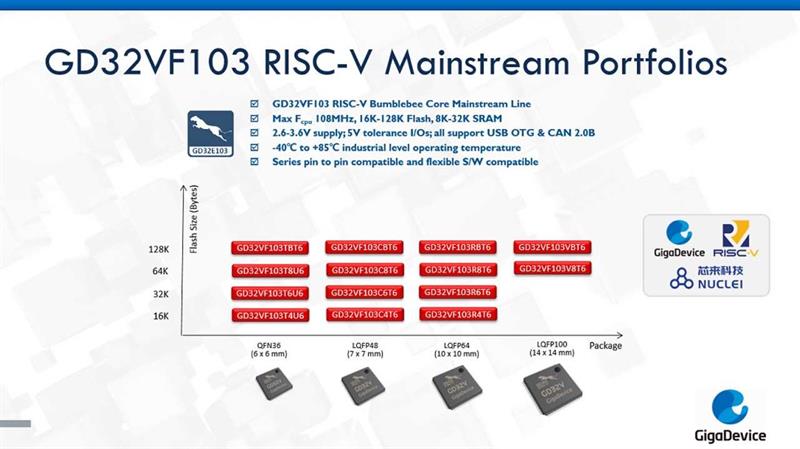GigaDevice provides complete tool chain support from MCU chips to software libraries and development boards creating a strong RISC-V development ecosystem.
As the first product line of the GD32 MCU family based on the RISC-V core, the new GD32VF103 series RISC-V MCU is designed for mainstream development needs, providing a cost-effective and innovative choice, whilst entering the mainstream market with balanced processing performance and system resources. The new products are available in 14 models, including QFN36, LQFP48, LQFP64 and LQFP100, and are fully compatible with existing GD32 MCUs in software development and pin packaging. This unprecedented and innovative design accelerates the development cycle between GD32's Arm® core and RISC-V core products,
making product selection and code porting flexible and simple. The new products are specifically targeted for embedded applications ranging from industrial control, consumer electronics, emerging IOT, edge computing to artificial intelligence and deep learning.
The GD32VF103 MCU series adopts the new Bumblebee processor core based on the open source RISC-V instruction set architecture. It is jointly developed by GigaDevice and China's leading RISC-V processor core IP and solution manufacturer Nuclei System Technology, offering a commercial RISC-V processor core for IoT and ultra-low power applications.
The Bumblebee core uses a 32-bit RISC-V open source instruction set architecture and supports custom instructions to optimize interrupt handling. It is not only equipped with a 64-bit wide real-time timer, but also it can generate timer interrupts defined by the RISC-V standard, with support of dozens of external interrupt sources, while possessing 16 interrupt levels and priorities, interrupt nesting and fast vector interrupts processing mechanism. Furthermore, the low-power management unit can support two-levels of sleep mode. The core supports standard JTAG interfaces and RISC-V debug standards for hardware breakpoints and interactive debugging. Additionally, the Bumblebee core supports the RISC-V standard compilation tool chain, as well as Linux/Windows graphical integrated development environment.
The Bumblebee core is designed with a two-stage variable-length pipeline microarchitecture with a streamlined dynamic branch predictor and instruction prefetch unit, while it incorporates a variety of low-power design methods. The performance and frequency of the traditional architecture three-stage pipeline can be achieved at the cost of the two-stage pipeline, achieving industry-leading energy efficiency and cost advantages.
These features allow the GD32VF103 MCU series to operate at up to 153 DMIPS at the highest frequency and under the CoreMark test achieves 360 performance points, which shows 15% performance improvement compared to the GD32 Cortex®-M3 core. At the same time, the dynamic power consumption is reduced by 50% and the standby power consumption is reduced by 25%.
The GD32VF103 series RISC-V MCUs provide a processing frequency of 108MHz, 16KB to 128KB of on-chip flash and 6KB to 32KB of SRAM cache, equipped with the gFlash patented technology, which supports high-speed core accesses to flash in zero wait time. Moreover, the Bumblebee core includes a single-cycle hardware multiplier, hardware divider and acceleration unit for advanced computing and data processing challenges.

The chip is powered by 2.6V-3.6V and the I/O ports can withstand 5V voltage level. It is equipped with a 16-bit advanced timer supporting three-phase PWM complementary outputs and Hall acquisition interface for vector control. Also, it has up to four 16-bit general-purpose timers, two 16-bit basic timers, and two multi-channel DMA controllers. The newly designed interrupt controller (ECLIC) provides up to 68 external interrupts and can be nested with 16 programmable priority levels to enhance the real-time performance of high-performance control.
In addition, the new MCUs have a variety of peripheral resources for a wide range of mainstream applications, including up to 3 USART, 2 UART, 3 SPI, 2 I2C, 2 I2S, 2 CAN2.0B, 1 USB 2.0 FS OTG and an External Bus Expansion Controller (EXMC). Among them, the newly designed I2C interface supports Fast Plus (Fm+) mode with frequencies up to 1 MHz (1Mb/s), which is two times faster than the previous speed. The SPI interface also supports four-wire system and more transmission modes, including the easy expansion to Quad SPI for high-speed NOR Flash accesses. Additionally, the built-in USB 2.0 FS OTG interface provides multiple modes such as Device, HOST, and OTG, while the External bus expansion controller (EXMC) is more convenient to connect to external memory such as NOR Flash and SRAM.
The product integrates two 12-bit high-speed ADCs with sampling rates up to 2.6MSPS, provides up to 16 reusable channels, supports 16-bit hardware oversampling filtering and resolution configurability and it has two 12 Bit DAC. Up to 80% of GPIOs have a huge variety of optional features and support port remapping, which continues to meet the needs of mainstream development applications with flexible and rich connectivity.
Commenting Deng Yu, executive VP of GigaDevice, general manager of GigaDevice MCU BU, said: "The RISC-V system has globally emerged and become a rapid development trend in the semiconductor industry for applications such as industrial control, Internet of Things, intelligent terminals and others. GigaDevice is the first in the industry to launch 32-bit general-purpose MCU products based on RISC-V architecture and continues to build and strengthen the RISC-V development ecosystem. GigaDevice
will further meet the market's differentiated demand for open architecture and cost advantages. We will continuously enrich the GD32 MCU 'department store', providing more innovative choices to our customers.”
The new GD32VF103 series RISC-V MCU samples and development tools are now available.













